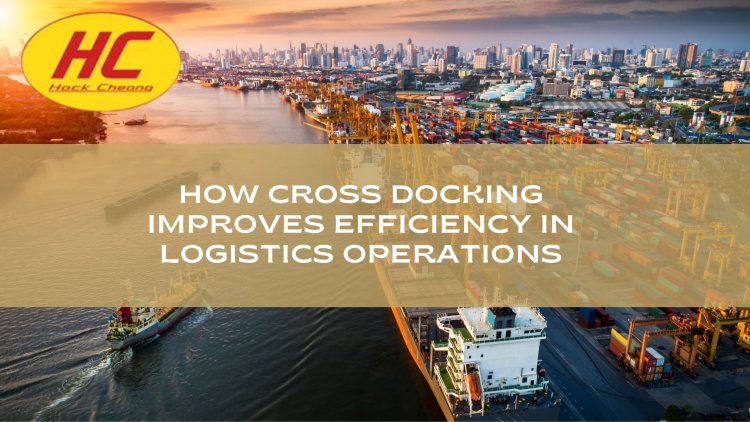How Cross Docking Improves Efficiency in Logistics Operations
In today’s competitive marketplace, speed, cost-efficiency, and streamlined supply chains are more crucial than ever. Customers expect faster delivery times, and businesses must find innovative ways to meet those expectations while managing operational costs. One proven strategy that has revolutionized logistics operations worldwide is cross docking.

What is Cross Docking?
Cross docking is a logistics practice where products from a supplier or manufacturing plant are distributed directly to a customer or retail chain with minimal handling and storage time. In a cross docking setup, incoming goods are quickly sorted and transferred onto outbound vehicles, often within a matter of hours.
Instead of storing products in a warehouse for days or weeks, cross docking allows businesses to move products almost immediately, speeding up the supply chain and reducing costs.
Key Ways Cross Docking Boosts Logistics Efficiency
1. Minimized Storage Costs
One of the most significant benefits of cross docking is the reduced need for warehousing. Traditional warehousing involves storing goods until they are needed, incurring storage costs such as rent, utilities, insurance, and labor.
Cross docking eliminates or dramatically reduces these costs by limiting the time goods spend in a facility. Products are quickly processed and sent out, which means you don’t have to pay for long-term storage or excess warehouse space.
2. Faster Delivery Times
Today’s consumers and businesses expect rapid delivery. Cross docking speeds up the supply chain by reducing the time between receiving goods and dispatching them to the final destination.
With goods spending minimal time at the docking terminal, businesses can meet same-day or next-day delivery expectations much more easily. This agility can be a powerful competitive advantage in industries like retail, automotive, pharmaceuticals, and grocery.
3. Reduced Handling of Products
Every time a product is handled, there’s a risk of damage, loss, or error. Traditional logistics often involve multiple handling steps — unloading, stocking, picking, packing, and shipping.
Cross docking minimizes product handling by moving items directly from the inbound dock to the outbound dock. Fewer touchpoints lead to less product damage, fewer errors, and improved order accuracy, which in turn results in happier customers and fewer costly returns.
4. Improved Inventory Management
Cross docking supports a lean inventory model by minimizing the need for stockpiling large quantities of goods. Businesses can operate with lower inventory levels, which reduces carrying costs and frees up capital for other investments.
Additionally, real-time tracking and inventory visibility are enhanced because products are constantly moving rather than sitting in storage. This dynamic flow allows for better forecasting, quicker adjustments to demand fluctuations, and reduced risk of overstocking or stockouts.
5. Streamlined Transportation
Cross docking consolidates shipments, allowing businesses to optimize transportation. For example, smaller shipments from multiple suppliers can be combined into a full truckload for a single destination, maximizing truck utilization.
This consolidation reduces transportation costs per unit, lowers carbon emissions, and improves delivery scheduling. It also simplifies route planning and increases the frequency of deliveries without significantly raising costs.
6. Enhanced Supply Chain Collaboration
Successful cross docking operations often require close coordination between suppliers, manufacturers, distributors, and retailers. This need for collaboration leads to better communication, shared technology systems, and improved partnerships across the supply chain.
When all parties work together seamlessly, businesses can respond faster to changes in demand, manage disruptions more effectively, and ensure a smooth flow of goods from source to customer.
Types of Cross Docking
To fully understand how cross docking improves efficiency, it's helpful to recognize that there are different types:
- Manufacturing Cross Docking: Receiving raw materials needed for production and sending them directly to manufacturing.
- Distributor Cross Docking: Consolidating products from various suppliers and delivering to customers.
- Retail Cross Docking: Combining products from multiple vendors for retail stores based on consumer demand.
- Opportunistic Cross Docking: Redirecting products already in the supply chain to meet sudden demand, without intermediate storage.
Each type serves a different purpose but shares the common goal of improving speed and reducing costs.
Challenges to Consider
While cross docking offers many benefits, it’s not without challenges:
- High Coordination Requirements: Suppliers must deliver on time and in the correct quantities.
- Advanced Technology Needed: Real-time tracking, warehouse management systems, and communication tools are essential.
- Not Suitable for All Products: Fragile, perishable, or customized goods may require more careful handling or longer storage.
However, with the right systems and partners in place, these challenges can be effectively managed.
Final Thoughts
In a logistics world driven by speed and precision, cross docking stands out as a powerful strategy to improve operational efficiency. By minimizing storage time, reducing handling, enhancing transportation, and supporting lean inventory practices, cross docking allows businesses to respond faster to market demands while saving money.
For companies looking to stay ahead in Malaysia’s dynamic economy — or anywhere else globally — investing in cross docking capabilities is no longer just an option. It’s a necessity for building a resilient, agile, and competitive logistics operation.
What's Your Reaction?















.jpg)